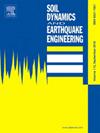Statistical analysis of earthquake ground motion coherency loss and a simplified evaluation method of its effect on structural responses
IF 4.2
2区 工程技术
Q1 ENGINEERING, GEOLOGICAL
引用次数: 0
Abstract
Almost all major seismic design codes state the necessity of considering spatially varying earthquake ground motions (SVEGM) in the analysis and design of large-dimensional structures but do not provide specific guides on modeling SVEGM, which are characterized by time lag and coherency loss. More than 100 coherency loss models have been proposed, but they exhibit significant variations, even for sites with similar conditions. Owing to the absence of a systematic study on the coherency loss ranges in current practice, the coherency loss models are rather arbitrarily selected in both research and seismic design, which may lead to inaccurate structural response predictions. This study conducted statistical analyses of available coherency loss models corresponding to three different site categories from open literature. The mean and standard deviation (STD) of lagged coherency loss functions are derived, providing a range of possible variations of coherency loss and a reference for the selection of a coherency loss for modeling SVEGM. The results are further used to derive dimensionless coherency loss effect modification coefficients as a function of structural vibration frequency, separation distance, and spatial ground motion time lag for structural response prediction. With this, the structural responses considering SVEGM can be straightforwardly obtained by multiplying the conveniently obtainable structural responses, which account for the wave passage effect only, with the corresponding modification coefficients, thus greatly reducing the calculation complexity. Analysis of application examples demonstrated that using the proposed modification functions generally improves the accuracy of structural response predictions considering SVEGM.
地震地震动相干损失的统计分析及其对结构响应影响的简化评价方法
几乎所有主要的抗震设计规范都指出了在分析和设计大维结构时考虑空间变化地震动的必要性,但没有对空间变化地震动的建模提供具体的指导,因为空间变化地震动具有时滞和相干损失的特点。目前已经提出了100多种相干损失模型,但即使在条件相似的地点,它们也表现出显著的差异。由于目前实践中对结构的相干损失范围缺乏系统的研究,在研究和抗震设计中,相干损失模型的选择相当随意,可能导致结构响应预测不准确。本研究从公开文献中对三种不同站点类别的可用相干性损失模型进行了统计分析。推导了滞后相干损失函数的均值和标准差(STD),给出了相干损失可能的变化范围,并为SVEGM模型中相干损失的选择提供了参考。在此基础上,推导了无量纲相干损失效应修正系数作为结构振动频率、分离距离和空间地震动时滞的函数,用于结构响应预测。这样,考虑SVEGM的结构响应只需将方便获取的仅考虑通道效应的结构响应与相应的修正系数相乘即可直接得到,从而大大降低了计算复杂度。应用实例分析表明,采用所提出的修正函数可提高考虑SVEGM的结构响应预测的精度。
本文章由计算机程序翻译,如有差异,请以英文原文为准。
求助全文
约1分钟内获得全文
求助全文
来源期刊

Soil Dynamics and Earthquake Engineering
工程技术-地球科学综合
CiteScore
7.50
自引率
15.00%
发文量
446
审稿时长
8 months
期刊介绍:
The journal aims to encourage and enhance the role of mechanics and other disciplines as they relate to earthquake engineering by providing opportunities for the publication of the work of applied mathematicians, engineers and other applied scientists involved in solving problems closely related to the field of earthquake engineering and geotechnical earthquake engineering.
Emphasis is placed on new concepts and techniques, but case histories will also be published if they enhance the presentation and understanding of new technical concepts.
 求助内容:
求助内容: 应助结果提醒方式:
应助结果提醒方式:


